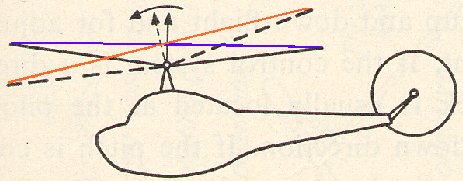|
||||||||||
|
|
||||||||||
|
||||||||||
|
|
||||||||||
The blade's change in location is the most obvious. As the blade rotates around the vertical axis, its location is changing. At one point in time, the blade will be aligned with the nose of the helicopter, and a tenth of a second later, that same blade will be aligned with the tail.
As the blades rotate, their pitch, which is defined as the rotation of the blade along its length, is constantly changing. There are two different types of these changes in pitch, and they are both the result of pilot inputs. The two different types of blade pitch changes are "collective" and "cyclic," and they share their names with the pilot controls used to control them. When a pilot wants to go up or down, he or she uses the "collective," which is mounted to the left of the seat. This control collectively changes the pitch of all the blades the same amount, increasing or decreasing the total lift of the rotor, and causing the aircraft to climb or descend. When a pilot wants to move forward, backward, or to the side, he or she uses the "cyclic" which is usually mounted between the legs. This control cyclically changes the pitch of the blades as they rotate. Let's consider the pilot wants to fly forward. He or she would then push the cyclic forward, which would cause the rotor blades to increase in pitch as they approach the rear of the helicopter, increasing lift in that area. If the pilot uses enough cyclic control, this can cause the entire helicopter to tilt forward, allowing the rotor to pull the helicopter through the air. This is often seen in war movies, since it is the best way to get going quickly, since a large portion of the rotor's thrust is pulling the helicopter forward. Believe it or not though, a helicopter can remain perfectly level and still move forward, backward or sideways, with the help of "flapping hinges."
Most people don't realize how complex a modern helicopter rotor really is. Along with the collective and cyclic controls, there are also various hinges, which allow the blades to move in different directions. The ones we are concerned with here are the "flapping hinges," which actually allow the blades to "flap" up and down as they rotate. The centrifugal force of the rotating blades keeps them from flapping out of control. Since the blades are free to move up and down like this, aerodynamicists use the term "tip path plane," (or TPP) which is defined as the flat plane that the tips of the blades create as they rotate. When a pilot inputs forward cyclic, this causes the blades at the rear of the helicopter to flap upwards, which causes the TPP to tilt forward. This forward tilt to the TPP then causes the helicopter to move forward. The illustration below shows the TPP for a helicopter both in hover (blue TPP) and forward flight (orange TPP).

In short, a helicopter is a very complex system, but these complexities are necessary for the helicopter to fly, let alone maneuver. In order to fly in any given direction, it is necessary to develop a thrust in that direction, either by tilting the entire helicopter, or simply by tilting the TPP.
If nothing else, this long explanation of one part of a helicopter's flight envelope shows how complex helicopters
really are. If they didn't possess such significant advantages over fixed wing aircraft, one might wonder if they
ever would've been as popular as they are now!
- answer by Doug Jackson, 7 July 2002
Read More Articles:


|
Aircraft | Design | Ask Us | Shop | Search |

|
|
| About Us | Contact Us | Copyright © 1997- | |||
|
|
|||